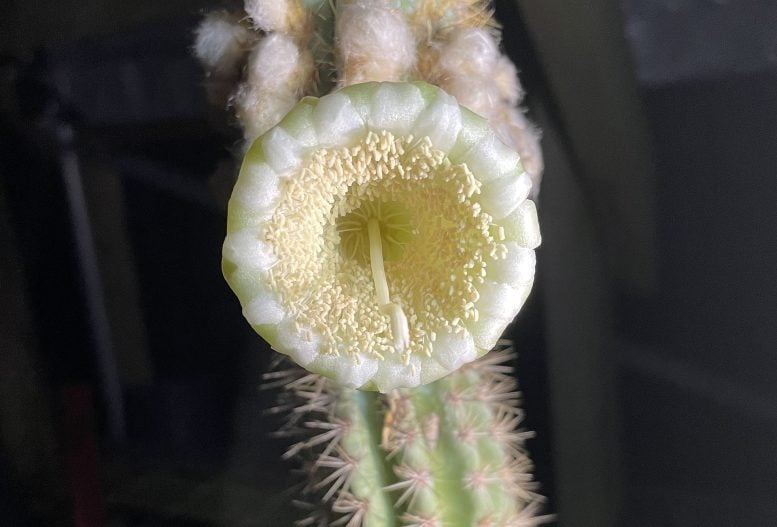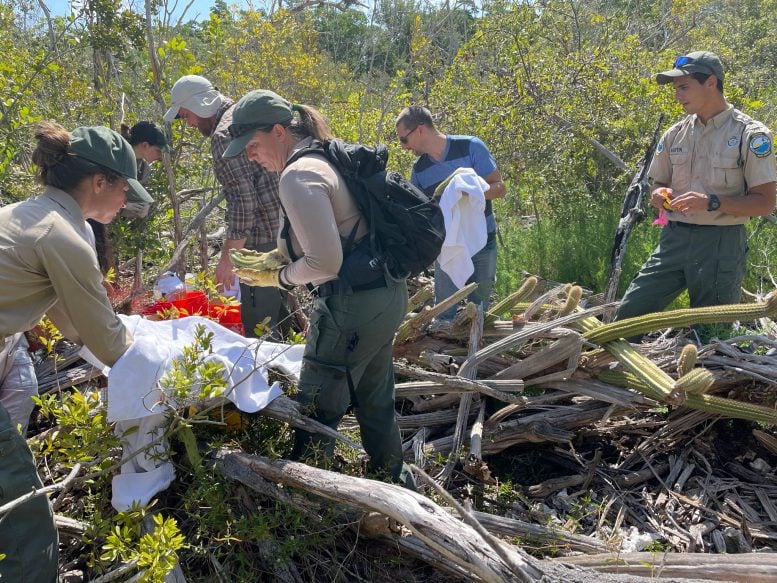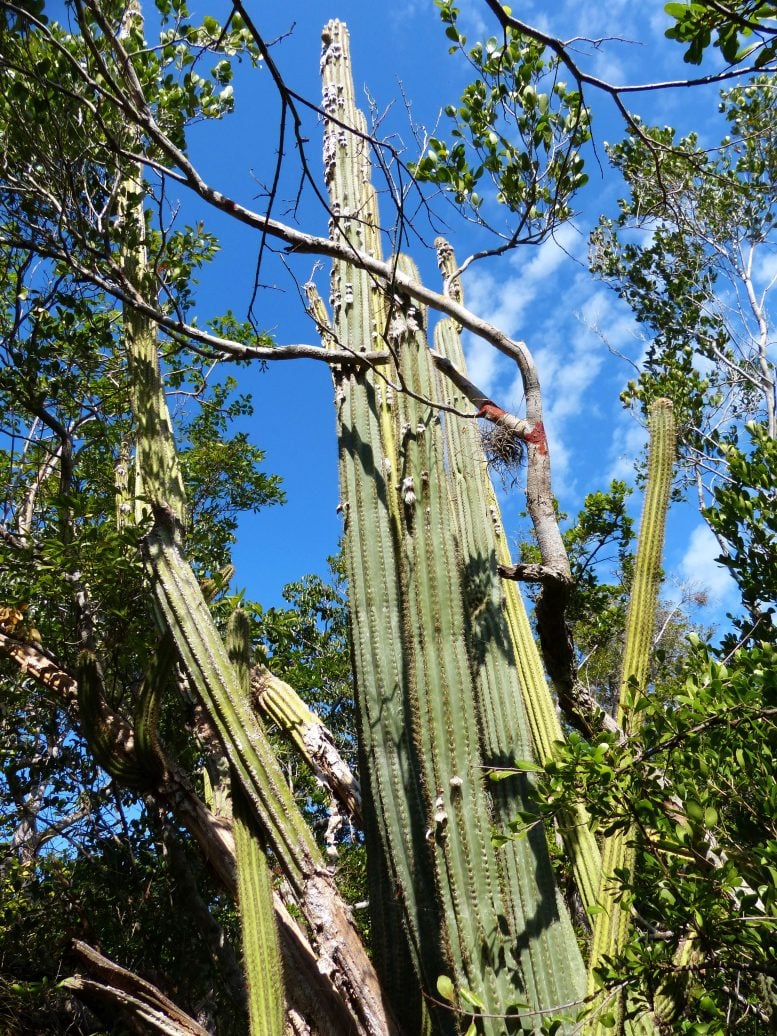
The Key Largo tree cactus was initially found growing in the United States in 1992 at a single site. That population has since been lost to a combination of rising sea levels and increasingly intense storms. Credit: Photo courtesy of Susan Kolterman
The United States has witnessed the local extinction of the Key Largo tree cactus due to sea level rise, a first in the country. The cactus, already under pressure from salt water intrusion, hurricanes, and animal grazing, has seen its last remaining stems salvaged for cultivation to prevent total extinction.
The United States has witnessed the complete loss of its sole population of the large Key Largo tree cactus, a development that researchers attribute to the first local extinction of a species in the country due to sea level rise.
The Key Largo tree cactus (Pilosocereus millspaughii) still grows on a few scattered islands in the Caribbean, including northern Cuba and parts of the Bahamas. In the United States, it was restricted to a single population in the Florida Keys, first discovered in 1992 and monitored intermittently since.
Saltwater intrusion from rising seas, soil depletion from hurricanes and high tides, and herbivory by mammals had put significant pressure on the population. By 2021, what had been a thriving stand of about 150 stems was reduced to six ailing fragments, which researchers salvaged for off-site cultivation to ensure their survival.
“Unfortunately, the Key Largo tree cactus may be a bellwether for how other low-lying coastal plants will respond to climate change,” said Jennifer Possley, director of regional conservation at Fairchild Tropical Botanic Garden and lead author on a study published Tuesday, July 9 that documents the population’s decline.
Two closely related cacti negatively affected by environmental change
Comparatively little is known about Florida’s rare cacti. Researchers initially stumbled upon the Key Largo tree cactus in an isolated mangrove forest, and for several years afterward, its identity remained uncertain. Most considered it to be a unique population of the similarly named Key tree cactus (Pilosocereus robinii), a federally endangered species that is present elsewhere in the Florida Keys.
The two cacti have a similar appearance. The stems of both shoot up perpendicular to the ground and can grow to be more than 20 feet tall. Both have cream-colored flowers that smell like garlic and reflect moonlight, attracting bat pollinators, while their bright red and purple fruit catch the eye of birds and mammals.
But there are key differences as well, which made Alan Franck, currently the herbarium collection manager at the Florida Museum of Natural History, suspect they were dealing with something unique on Key Largo.
“The most striking difference is the tuft of long, woolly hairs at the base of the flowers and fruits,” Franck said. The hair is so thick, it can look as though the cactus is covered in drifts of snow. Spines of the Key Largo cactus are also twice as long as they are on the Key tree cactus.
In 2019, Franck confirmed that the Key Largo population was the first and only known instance of Pilosocereus millspaughii in the U.S.
By then, it was succumbing to some of the same environmental pressures that had plagued its relative, the Key tree cactus, over the last century. The latter was once common throughout the Florida Keys, but its numbers dipped dangerously low as more people moved to the area.
Writing in 1917, botanist John Small noted that the Key tree cactus “was for a long time very abundant [on Key West]…In recent years, with the destruction of the hammock for securing firewood and for developing building sites, this interesting cactus has become scarce, until at present it is on the verge of extermination in its natural habitat.”
The Key tree cactus was listed as federally endangered in 1984, but its numbers continued to wane. Between 1994 and 2007, it decreased by 84%.
Researchers at Fairchild began monitoring all of the tree cactus populations annually in 2007, working in tandem with local land managers. One Fairchild-led study showed that salt levels were higher in soil beneath dead vs. living cacti in the years following a storm surge event in the Lower Keys, drawing a clear connection between mortality and increased salinity.
Researchers also initiated a robust conservation collection for these species. Potted cacti are grown at a facility in Coral Gables, Florida, and seeds from both wild and cultivated plants are carefully banked for long-term conservation.
Researchers study and rescue the remnants of a dwindling stock
The Key Largo tree cactus grew on a low limestone outcrop surrounded by mangroves near the shore. The site originally had a distinct layer of soil and organic matter that allowed the cactus and other plants to grow, but storm surge from hurricanes and exceptionally high tides eroded away this material until there wasn’t much left.
Salt-tolerant plants that had been previously restricted to brackish soils beneath the mangroves slowly began creeping up the outcrop, an indication that salt levels were increasing.
Given enough time, these changing conditions would likely have killed the cactus. But other incidents occurred that hastened the pace.

Staff from Fairchild and the Florida Department of Environmental Protection removed all remaining green material in 2021 after it became clear the population was not going to survive. Credit: Photo courtesy of Jennifer Possley
“We noticed the first big problem in 2015,” said study co-author James Lange, a research botanist at Fairchild. When he and his colleagues arrived to evaluate the plants that year, half of the cacti had died, apparently as a result of an alarming amount of herbivory. Cacti store reserves of water in their succulent stems, which allows them to survive for long periods of time without rain. This makes them enticing to animals when other sources of water are scarce.
“In 2011, we started seeing saltwater flooding from king tides in the area,” Lange said, referring to particularly high ocean tides. “That limits the amount of freshwater available to small mammals and might be related to why the herbivores targeted this cactus, but we can’t say for sure. We’d never seen cactus herbivory like this anywhere in the Lower Keys, where flooding has tended to be less extensive.”
The team set out cameras in hopes of finding the culprit, but whatever it was did not return, and there was no evidence of significant herbivory thereafter. Yet, when the team came back the following year, roughly another 50% of the population had died. In response, staff from Fairchild and the Florida Department of Environmental Protection took a few cuttings of what remained to grow in greenhouses.
In 2017, category 5 Hurricane Irma swept across South Florida, creating a 5-foot storm surge. The highest point on Key Largo is only 15 feet above sea level, and large portions of the island remained flooded for days afterward. Once the storm had passed, the Fairchild team conducted triage with several cactus populations throughout the Keys, removing branches that had fallen on cacti and salvaging other ill-fated material. Conditions were so extreme that biologists had to put out kiddie pools of freshwater to keep local wildlife alive.
Exacerbating the already degrading Key Largo tree cactus habitat, king tides in 2019 left large portions of the island, including the extremely low-lying outcrop, flooded for over three months.
By 2021, there were only six Key Largo tree cactus stems left. As it was clear the population wasn’t going to survive, the team allowed the plants to flower and fruit for the remainder of the year, then salvaged all remaining green material and replanted it in greenhouses or controlled settings outdoors. At present, researchers know of no naturally growing Key Largo cacti in the United States.
“We have tentative plans with the Florida Department of Environmental Protection to replant some in the wild,” Possley said.
Similar efforts are responsible, in large part, for the continued existence of the related Key tree cactus in Florida. “The amount of reintroduced material of this species is already more than the amount of wild material that’s left,” Possley said.
But, she added, this may end up being more of a stopgap than a solution. Environments suitable for tree cacti are disappearing along with the plants they support. “It’s generally a fringe between the mangroves and upland hammocks called thorn scrub, and there just aren’t many places like that left where we can put reintroduced populations.”
The decline of the Key Largo tree cactus and the necessity of its removal has given researchers an idea of what to expect in the future as species contend with a rapidly warming world. Instead of a smooth, predictable rise in sea or salt levels, the reality of climate change is messier and manifests itself in a complex series of related events that put additional pressure on species that are already stressed.
“We are on the front lines of biodiversity loss,” said study co-author George Gann, executive director for the Institute for Regional Conservation. “Our research in South Florida over the past 25 years shows that more than one in four native plant species are critically threatened with regional extinction or are already extirpated due to habitat loss, over-collecting, invasive species, and other drivers of degradation. More than 50 are already gone, including four global extinctions.”
Reference: “First U.S. vascular plant extirpation linked to sea level rise? Pilosocereus millspaughii (Cactaceae) in the Florida Keys, U.S.A.” by Jennifer Possley, James J. Lange, Alan R. Franck, George D. Gann, Trudy Wilson, Susan Kolterman, Janice Duquesnel and Joseph O’Brien, 9 July 2024, Journal of the Botanical Research Institute of Texas.
DOI: 10.17348/jbrit.v18.i1.1350
The study was funded by the Florida Department of Agriculture and Consumer Services.










There is no evidence of sea rise and high tides are not the same thing.
More pseudo “science” to push an agenda.
“Local extinction” is more properly called extirpation, which at least the authors of the cited study realize, even if whoever wrote this press release doesn’t.
“The Key Largo tree cactus grew on a low limestone outcrop surrounded by mangroves near the shore. The site originally had a distinct layer of soil and organic matter that allowed the cactus and other plants to grow, …
Organisms that are specialists live a more precarious life than generalists because the environment is always changing. Evolution is driven by environmental stress. Evolution doesn’t just mean changes in a species, it means changes in the composition or mix of species in an ecosystem. IF there is or was only one remaining locality suitable for this cactus in Florida, then it was living on borrowed time. When a thorny exotic species takes hold, people get concerned about that too. One can’t have it both ways. Humans may lament the extirpation of a species, but in the bigger picture, Nature cares little because it opens a niche in that ecosystem to be filled by other organisms.